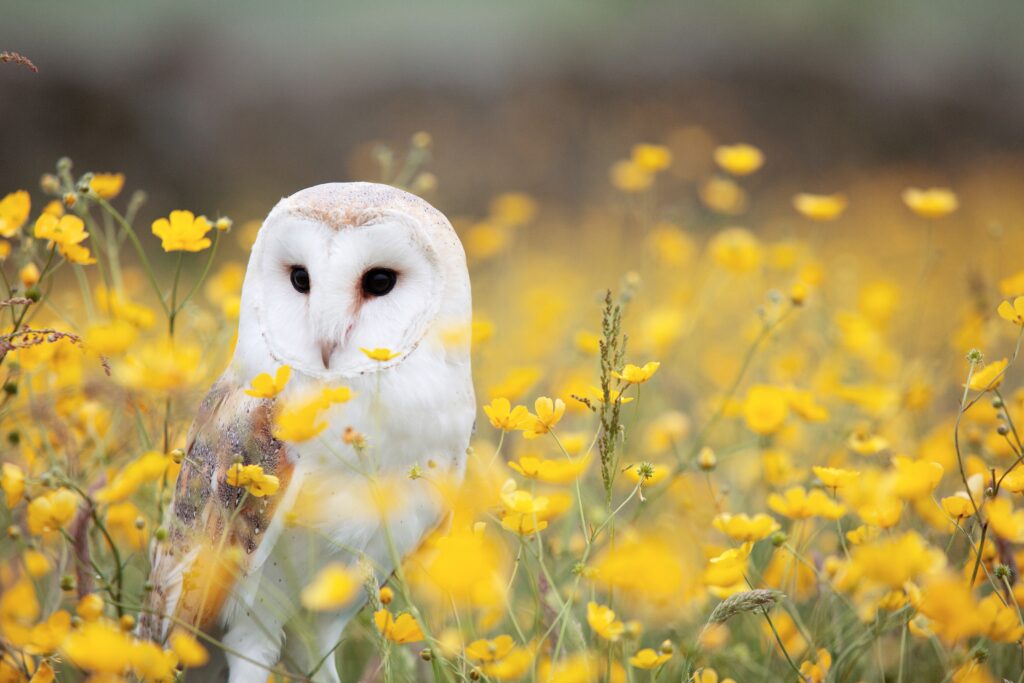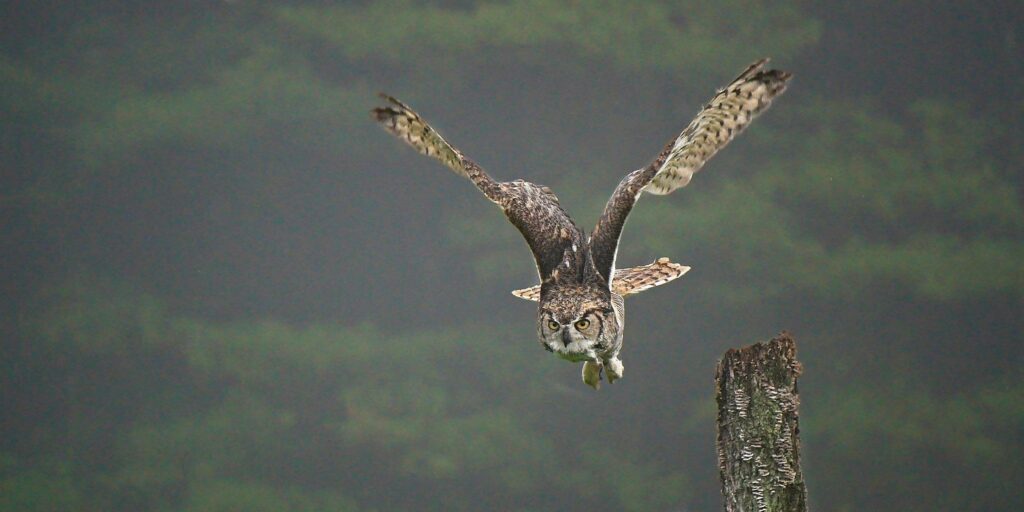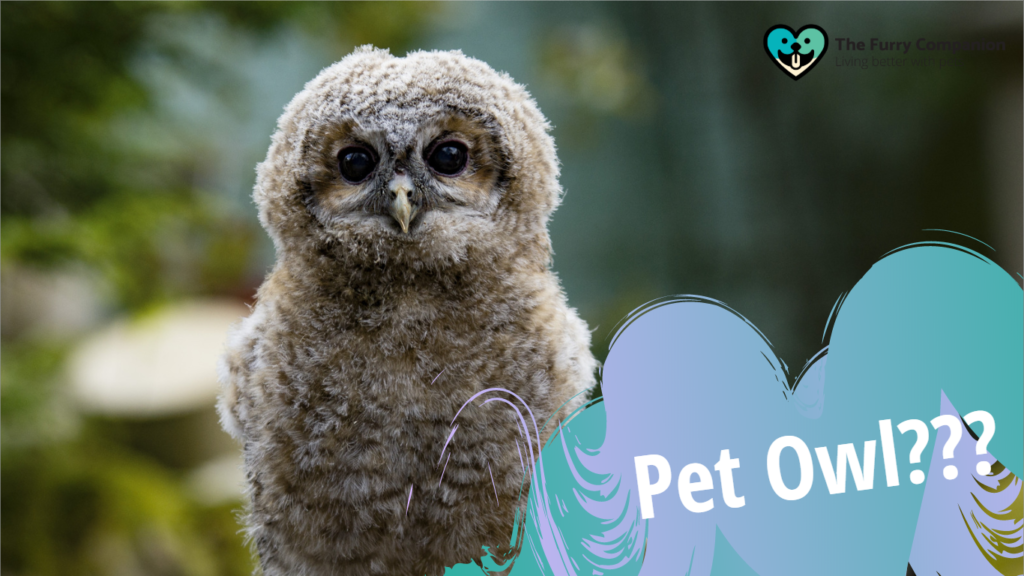Any avid fan of the Harry Potter series has dreamt of getting a Hedwig of their own. Outside the box office, snowy white owls are not nearly as obedient as Mr. Potter’s. Any owl species is difficult to hold captive or domesticate. Wanna-be pet owl owners need to approach this decision with caution because of the challenges these feathery friends bring. Check out Harry Potter series in Amazon here.

The thought of having an exotic and unique pet that fulfills your childhood dreams may be exciting, but think about the responsibility and legal limitations of domesticating an owl. Before you go looking for an owl to make your pet, hear out The Furry Companion’s stand that owls do not make good pets.
Table of Contents
Types of Owls
There are more than 225 species of owls in the world. They fall under one of two types: the Tytonidae family and Strigidae family. Barn owls make up the Tytonidae family with their distinct heart-shaped face. The rest of the owls belong to the Strigidae family, the more typical side of the hooters clan.
Certain regions of the world have a unique owl species inhabiting there, except for the Antarctic. Here are the most common owls you might more or less be familiar with.
1. Barn Owl
The typical barn owl, Tyto alba, goes by many names: ghost owl, monkey-faced owl, death owl, hobgoblin owl. They have long, flat faces with big, rounded wings to carry them to the sky. With their white, heart-shaped faces outlined with white or golden brown rims, they are a peculiar owl to meet. Their facial features will leave a striking impression on you.
Another striking fact about barn owls is that they are monogamous creatures. These little feather balls are in it to mate for life! Talk about commitment.

If you want to see them in their natural habitat, you may find them relaxing in open grasslands or meadows in North America. You may also find them in the Midwest, where they are already locally endangered. “Barn owls thrive in areas where there are farms that grow grasses and grains and things like that,” Belinda Burwell, DVM says. When you see a barn owl perching on a tree, get a hold of yourself because you cannot make them your pet owl! You can purchase BARN OWL: The complete guide on everything you have to know about barn owl; care, health, diet, lifespan, description, and behavior in Amazon here.
2. Great Horned Owl
Bubo virginianus, or the great horned owl, is the most predominant species out there! No, you also cannot make them your pet owl. Belonging to the bigger owls, the great horned owls are intimidating creatures. Bird enthusiasts and ordinary people can quickly identify them because of their ear tufts. These tufts are not even ears!
The color of their plumage differs from each geographical location. Great horned owls located near the tundra regions have lighter feathers. Meanwhile, those residing in the forests have darker plumage. This trait is primarily for survival so that they can camouflage themselves in their respective habitats.
Great horned owls are as scary as they look! They are aggressive hunters, and they are fearless. When threatened, these 22-inch-tall owls attack other animals bigger than them like dogs. Check out Great Horned Owls on Amazon here.
3. Snowy Owl
This portion is for the Harry Potter fans wanting to know more about our favorite carrier, Hedwig. A Bubo scandiaca, Hedwig’s species, flock to the cold northern parts of the world like Canada, Europe, Asia and the northern part of the United States. Since this type of owl feasts on ducks, seabirds, and mice, their migration depends on the availability of lemmings in the area. Unlike other owl species who hunt during the night because of their nocturnal habits, snowy white owls hunt during the day. They are diurnal.
Interestingly, as male snowy whites get older, their plumage can turn completely white with a dusting of dark specks. On the other hand, female Hedwigs become more mysterious when they grow older.
And that’s not even the best part about them! They have little fluffy feathers to keep them warm from the cold environment. Too bad these species aren’t pet-able.
4. Eurasian Eagle-Owl
At last, it has come to the Eurasian eagle-owl! Yes, you can make them a pet owl. Bubo bubo species are owls with prominent ear tufts that look like “eyebrow” feathers sticking atop their eyes, making them look eternally stern. These ear tufts look similar to those of the great horned owl. However, the two differ in the color and size of the eyes. Eurasian eagles have unmistakable orange eyes. Black and brown feathers cover their bodies, their faces framed with rims of freckles.
These species are one of the largest in the world! With a six-and-a-half- foot wingspan, no other owl can beat their reach. Messing with a Eurasian eagle-owl is no joke! They are known to prey on adult foxes and young deer. Be careful not to startle them at home!
Eurasian eagle-owls rule the deserts, coniferous forests, and grasslands of North Africa, Asia, Europe, and the Middle East. They are the species with the least concern of endangerment because of their vast number around the globe.

Challenges of Owning a Pet Owl
For hopeful owners, bear in mind that some laws prohibit the domestication of particular owl species.
In the United States, for instance, it is illegal for private individuals to make native owls their pet. An example of a native owl is the snowy owl, so say goodbye to your Hedwig dreams. They are under the protection of the Migratory Bird Treaty Act. You cannot even possess a single feather of theirs without securing a permit from the US Fish and Wildlife Service.

Owning a pet owl, especially native owls, means securing government-issued permits, even for educational purposes. Only licensed and trained experts are legally allowed to care for native owls, either for domestication or rehabilitation. Sometimes, when animals have disabilities, an expert caretaker temporarily adopts this creature until it heals. Based on the law, caretakers need to return it to competent shelters upon its recovery.
Owning non-native owls like the Eurasian eagle-owl and speckled owl is legal in the United States. In the UK, you can have a pet owl regardless if it is native or not. Nevertheless, as a responsible pet owner, you would still have to learn and train yourself in owl care.

Challenges in Living with a Pet Owl
Notwithstanding people’s fascination with the Harry Potter series, owls are magnificent creatures. They are wild animals that glide in the dim sky. With their sharp talons and tubular eyes, owls make excellent hunters among the bird species. Their camouflaging plumage helps them hide from attackers when they are vulnerable during the day.
Cartoons and stories portray owls as intelligent or wise animals. However, studies find other birds are smarter than owls. Given a simple cognitive test of pulling a string to receive a treat, other bird species discovered the secret of getting treats. On the other hand, owls found it a difficult task. This discovery does not make owls less fascinating creatures. They still hone particular charms.
Owl Chow
Now, what do owls eat? In their natural habitat, undomesticated owls depend on available food sources. However, preparing a meal for your pet owl is a different story. They will ravage what you give them.
Owls are raptors; they are carnivorous. Thus, having a pet owl is a lot of work. You can easily feed pet dogs and other domesticated animals. In any grocery store, you can immediately find the dog food aisle. In the case of a pet owl, they eat raw meat. They are hunters who strongly prefer rodents, the food you cannot find in any grocery. A pet owl’s diet may consist of mice, small rabbits, quails, guinea pigs, and little chickens. Persistent owl owners, however, typically trap and freeze mice for their pet’s lunches.

Imagine the time and effort spent on procuring chow for your pet owl. The owner needs to thaw out the carcass and cautiously feed the pet owl. Other owners feed them live chow.
Owls are wild pets designed to hunt and kill prey. If you think sourcing its food is a challenge, you cannot imagine the actual feeding. Owls swiftly glide in the sky looking for prey below. They will pounce at the opportunity for food. It’s an owl’s instinct to prey; it is part of their genetic code. Whether they are captive or not, their abilities never change. Be careful while feeding your pet owl. They might mistake your hand for a meal.
Owl’s Messy Habits
All birds are messy, but owls are the messiest avian. Since they only eat animals like rodents, owls have dirty eating habits. They tear their food to bits so that it will be easier to consume. Cleaning up after feeding time is part of a pet owl owner’s job, and it does not stop there.
If you are looking to own a pet owl, be ready for the poop. These birds are notorious for pooping a lot. Pet parrots have a strict vegetable-only diet, and vegetables are easier to digest. Due to a pet owl’s meat diet, owl poop usually emits a foul odor.
Moreover, keeping your pet owl’s aviary spotless is a demanding task. Owls regurgitate the indigestible bits of food. They also leave pellets, furry balls of bones and fur that need regularly clearing.
Owl’s Sleeping Habits

Nocturnal by nature, owls are more active during nighttime, which means they’re the noisiest during the quietest hours of the day. When you are about to rest from a full day, your pet owl’s daily life is just about to begin.
Unless you are the type of person who is more active in the night, a pet owl may not be the best choice. They will hoot all night, especially during the mating season. For owls living in sub-Arctic or temperate areas, their mating season occurs sometime during spring. It entails a lot of loud mating calls that are sure to disturb the neighborhood. Your neighbors will not be happy being awakened by hoots.

Owl Care
Owls are demanding pets in need of constant care. They require high maintenance. In the wilderness, they are free, and nobody is responsible for them. Inside the home, however, they need to be regularly cleaned up after. Therefore, it is difficult to go on vacations when you have a hungry pet owl, and no rodents are running around.
A typical pet sitter does not usually accept pet owls, and owl kennels are not abundant. Only experts are suitable sitters for such wild creatures. It is also challenging to look for a veterinarian. Owls demand specialized care, and veterinarians are usually not trained with owl health and care. Pet owl owners need to look for doctors who are comfortable working with owls.
As a caregiver, you would also need to know how to care for your pet owl properly. Owners need to identify signs indicating health problems like normal poop and changes in behavior. Aside from that, they need to provide adequate space for the bird to fly around and prepare healthy food for their pet owl. After sufficient training and lessons, people may apply for a permit.
Owls are Antisocial and Independent
Compared to other birds, owls are often independent and live alone with their offspring and mate. They are antisocial birds that can fend for themselves, unlike macaws.

Interestingly, owls lack the flock mentality that parrots have. Due to this mindset, parrots integrate more quickly in the family setting compared to owls. Owls view other birds or beings as enemies or prey and will most likely attack others on sight. As a hopeful owl owner, be careful when you are around owls. Better get on their good side before deciding to adopt them.
If you are looking for pets that are loving and expressive, do not expect that from a pet owl. Birds are not the most affectionate animals, even more so for owls since they are wild creatures. Even captive birds do not want to be hugged or cuddled or taught tricks, unlike parrots. Falconers have special gloves to wear so that owls and other birds can rest atop their arm. This action is practically the closest act of affection a falconer can get.
Pet owls expect high demands of care but do not return the favor. They are not the type to perch on your shoulder and nuzzle your neck. They scratch and prey instead. If you are looking for an animal to keep you company and pet, do not get a pet owl. It is best to adopt a playful dog. Even held captive, owls maintain their cold instincts.

A Pet Owl Is a Long-Term Commitment
Caring for an owl is an extremely long hooting commitment. For example, a great horned owl in captivity has a lifespan of 30 years or longer if handled well.
Meanwhile, smaller species could live up to 10 years. The commonly captive Eurasian eagle-owl can live up to 50 years! Owners need to consider the amount of commitment this length of time entails. If it were not for their primal instincts, owls might be good life companions.
There is also a set of rules for owls in captivity. For example, setting a human-imprinted barn owl free after years of captivity is illegal in the UK. Releasing them into the wilderness is practically a death sentence. Finding a new home for them in sanctuaries could be difficult since they are usually at overcapacity.
How to Get a Pet Owl
At this point, you may already be hyped to soar high with your pet owl. These days you can find a breeder of birds, called a falconer, online. Listings of owls for sale are available on several websites.
Aspiring owl parents need only look for a trustworthy and reliable supplier. Native birds like the Eurasian eagle-owl are legal to purchase in certain countries and usually cost around $3000. Buyers should be mindful of purchasing native birds, especially if their trade is illegal in specific areas.
Even if you do find a trustworthy falconer online, you have only solved a quarter of your problems.
Each country has its own rules about keeping pet owls. For instance, it is prohibited in the United States to keep a pet owl unless they are licensed and trained rehabilitators, falconers, or educators. If you want to become a bonafide pet owl owner, you would need to transform your lifestyle into that of a dedicated and committed falconer—with a permit! Never forget the falconry permit.
Here are some tidbits on becoming a pro falconer.
- Check the falconry permit requirements in your county. It differs per region, so you better get the right information and come prepared for the next challenges.
- Fly under a master falconer’s wing. Rigorous training starts by looking for your sponsor, an experienced falconer, to guide you for at least the first two years. Some laws require new falconers or apprentices to undergo training.
- Take the exam. Yes, you need to pass an exam before you get your license or your falconry permit. Not only will your motor and training skills and experience be put to the test, but also your knowledge. It is a rigorous way to assess who indeed knows the caring procedures for these raptors. You better study until you know your Owl 101 like the back of your hand.
- Build an owl sanctuary. If you think a test was tedious, you will realize how meticulous it is to own a pet owl. We’ll discuss how to make a suitable home for your bird buddies in a bit because you need to prepare the actual thing before receiving custody of your pet owl. Authorities will check and approve the living conditions you will be providing your pet owl. The state’s wildlife agency will inspect the facilities and make sure they adhere to the strict legal requirements. In addition to that, you also need to prepare the necessary equipment.
Creating a Sanctuary for Your Pet Owl
When it comes to creating a living space for pet owls whose natural habitat is the wild, no litter box or cage will suit them. Owls are freedom-loving creatures and need their space. They cannot live in a standard-sized parrot cage. The best place to house pet owls is a substantial aviary setting with protective bars and a stand to perch on.
If you do not want your home covered in bird poo, then an aviary is the way to go. Giving your pet owl ample space also protects your furniture and pillows from being ravaged by sharp talons and beaks. With their killer instincts, they attack anything. They can target your clothes, blankets, and stuffed toys.
Since pet owls keep their destructive instincts intact, it is best to create an aviary with sturdy wire instead of wood. Owls have incredibly sharp talons that can scratch wood to the core. It is best to situate this aviary in a spacious, open area. Owls need exercise too! They need to stretch their wings and fly around your backyard. Giving them an expansive lawn to live and stay in is expensive and a burden to maintain. Owners can opt for large cages to house their pet owls. Lianne McLeod, DVM adds, “They require a steady diet of small animals (fed whole). They are not sociable, and need room to fly and hunt.”
Making owls more high maintenance is the accumulation of dust and dirt on their wings. An owl’s wings caked in mud make noise in flight. This whistling and bustling sound makes it hard for them to hunt. Therefore, providing a large bathing pan is ideal for pet owls.
The Verdict
Now you have discovered what it takes to become a proud owner of a pet owl. It is a challenging feat. “Physical contact between human and wild animals whose health is not monitored or maintained can potentially enable disease transmission like the bird flu, chamydiosis, salmonellosis, toxoplasmosis, and leptospirosis,” Wita Wahyudi DMV warns. Although you may want to realize your magical dreams, having a pet owl is not the best decision. We at The Furry Companion believe these majestic creatures should be free in their natural habitat unless incapacitated.
However, there are alternative ways to see owls in action.
Adopt an Owl
Existing nonprofit organizations around the world allow individuals to own owls symbolically. Through adoption, people donate to the center. In turn, this will give donors a pass to visit and interact with owls. These donors will also receive a certificate. This option will allow you to support the animal you love.
Volunteer at an Owl Sanctuary
Another way you could show support for owls is by volunteering at a nearby owl sanctuary. Through this, you can get to learn more about them. Owl sanctuaries are under the management of expert bird caretakers so that you will gain first-hand information and techniques from the experts.
Frequently Asked Questions
Can you have an owl as pet?
Yes, but it requires training and licenses to be able to keep one. There are also restrictions on which types of owls can be adopted. Although, it is allowed it will be hard to obtain one because of the strict regulations.
How much does it cost for an owl?
Owls are around $1000. The Eurasian Eagle owl, for example, costs around $3000 to $5000. While buying one could be costly already, the maintenance that a pet owl needs will be as costly a lot as well. Owls are carnivores and will need their daily supply of quail, rats, rabbits, and mice. Also, an owner would need to provide a large space for this animal to roam and fly around. Apart from these, the licenses and training will come at a price as well.
Can you have a pet owl in Nevada?
Nevada prohibits owning pet owls. The NAC 503.205 does not allow anyone to own an owl as a pet. Owls are migratory birds and The Migratory Bird Treaty Act protects these animals from being held in captivity.
Are Owls affectionate?
Owls are aloof and they need lots of space. Although they are portrayed as affectionate animals in books and films, the opposite is true in real life. Their affection mostly is for their mates.
Do owls like humans?
Owls are most likely to avoid humans. It is not common for owls to attack humans unless they felt threatened.
Are Owls friendly?
Owls enjoy being alone since they are territorial creatures. Younger ones may be more friendly but when they mature they are mostly unfriendly and cranky. This animal is not very sociable.
Do owls attack dogs?
Owls are carnivorous and dogs can be potential prey. Although, owls are not big creatures and might only carry small dogs.
How do you attract owls?
If you are interested in attracting owls into your yard, follow some of these useful tips. Try setting up a nesting box where owls can build a home. Also, turn off the yard lights because owls tend to veer from bright lights. Leave the grass a little tall to foster a hunting ground for them. Lastly, install a birdbath which they could use for drinking and bathing.
Are owls intelligent?
Although pet owls are shown to be intelligent and perceived as symbols of wisdom and nobility, scientific evidence shows that they do not have relatively large brains. Captive owls which have undergone intelligence tests revealed that these majestic creatures do not have well-developed mental capacities. They cannot solve problems intended for domesticated animals.
Which owl is best for a pet?

